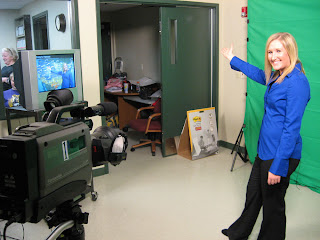
Greenscreen, chromakey, bluebox, keying....all different words for a technique used to layer one image over another. And keying is almost as much an art as it is a science.
We've just finished taping about six weeks worth of television and radio newscasts for speech contest, and in the process, we've had about every technical problem possible occur. Right now, I'll concentrate on some things we've learned about greenscreening.
We used greenscreen for weathercasts and for a virtual background for sports and special features, and keyed the background whike shooting (as opposed to keying in post production). These ideas apply to both situations.
1. Lighting. If possible, light the screen separately from the talent. Your goal is to create a flat, even light on the screen. Shadows or light and dark areas all make a clean key more difficult. which brings us to...
2. Distance. Have your talent at least three feet away from the greenscreen. Any shadow that falls on the screen will mess up your attempt to key. So, if you move the talent farther away from the screen, their shadow falls on the floor instead of on the screen.
3. Put your camera on manual focus, and then focus carefully on the talent. The easiest way to do this is to zoom in to the talent, focus, and then zoom back to the desired focal length. This throws the background out of focus, which hides wrinkles and imprefections in the greenscreen.
4. Set your camera to manual exposure. If it's on auto-exposure, then any change in the exposure setting will mess up your key. Something as simple as the talent holding up their script can change exposure, which changes your key, which drives you crazy. So, switch to manual exposure.
5. Wardrobe. I've had good luck with the talent wearing darker colored clothing, but to be safe, I ask them to bring two outfits...if one doesn't key well, perhaps the other one will. Also, stay away from frizzy or spiked hair-dos. That irregular edge will give your talent a green halo.
6. Weather maps or backgrounds should be a darker color. If the JPEG you are keying is white or a light color, any green fringing is obvious to the viewer. A darker JPEG helps to hide fringing.
7. Place a monitor on both sides of your talent. If the camera is at 12 o'clock and your talent is at 6 o'clock, you should have a monitor at 10 and 2 o'clock. These monitors should show the chromakey output, so the weatherperson can see what the heck they ar pointing at.
8. Let your talent practice before you shoot. Pointing out in thin air and hoping you are pointing at Phoenix or Pittsburg takes some practice. Let them get the feel of this virtual world before the cameras roll.
And finally, take your time. It seems like taping a weathercast is one of the most stressful jobs when producing a TV newscast. So don't assume you can crank out a five minute weathercast in ten minutes. Plan enough time to keep your talent (and you) from stressing out.
1 comment:
Absolutely helpful tips. I have been into green screen photography since long and the major part that consumes most of time and energy is lighting the subject and the screen evenly.
Post a Comment